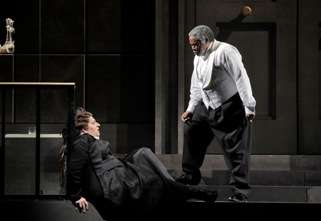|
Back
A highly recommended production Chicago
Lyric Opera
11/01/2017 - & November 5, 10, 14, 18*, 26, 30, 2017
Richard Wagner: Die Walküre
Brandon Jovanovich (Siegmund), Elisabet Strid (Sieglinde), Ain Anger (Hunding), Eric Owens (Wotan), Christine Goerke (Brünnhilde), Tanja Ariane Baumgartner (Fricka), Whitney Morrison (Gerhilde), Laura Wilde (Ortlinde), Catherine Martin (Waltraute), Lauren Decker (Schwertleite), Alexandra LoBianco (Helmwige), Deborah Nansteel (Siegrune), Zanda Svede (Grimgerde), Lindsay Ammann (Rossweisse)
Lyric Opera of Chicago Orchestra, Sir Andrew Davis (Conductor)
David Pountney (Director), Johan Engels (Original set designer), Robert Innes Hopkins (Scenery designer), Marie-Jeanne Lecca (Costume designer), Fabrice Kebour (Lighting designer), Denni Sayers (Choreographer)

C. Goerke, E. Owens (© Cory Weaver)
The Lyric Opera of Chicago keeps amazing me. I have been to four productions in one year and what is remarkable is their flair for nearly perfect casting. Many top opera houses, including prestigious ones, tend to focus their productions around one or two superstars, to the detriment of the supporting roles. The Lyric’s production of Die Walküre was definitely a case in point of the Lyric’s casting prowess.
From Wotan and Brünnhilde to the last Valkyrie, one could not have hoped for better. Christine Goerke is one of today’s leading dramatic sopranos. She had great facility with the role’s dramatic passages, yet she was expressive throughout the opera. Her “Hoyotoho” at the beginning of Act II was impressive, clear and strongly supported. Her Act II duet, with Siegmund conveying his impending death, was extremely moving. Following the charged exchange with Siegmund, one was easily convinced of her change of heart and defiance of Wotan’s declared will. Most moving was her final duet with Wotan and her fear of being defiled by a mortal, once awakened from the long slumber she was destined for.
Eric Owen was an ideal Wotan, noble and expressive. Other bass-baritones may have sturdier voices, but Owen’s voice is a perfect fit for the role, as he is able to convey the Nordic God’s incipient doubts and hesitation. His rendition of the Act III finale “Leb wohl du kühnes herrliches Kind” was tremendous, bringing more than one member of the audience to tears. He managed to convey his authority as the king of Gods as well as his tenderness for his favourite daughter. Brandon Jovanovich was a glamorous, handsome and young looking Siegmund. At moments, the voice seemed burdened by the music, but overall his voice was more than adequate. He acted well as the troubled and tired young warrior. His “Winterstürme” was lyrical and tender. His heroic Act I cry, “Nothung,” appropriately sent shivers down one’s spine.
Elisabet Strid was a touching Sieglinde. Her Act One love duet with Siegmund was passionate, conveying desire and yearning. She perhaps inhabited the role of the victim too well, so that even in her moments of bliss in the love duet, she seemed still sad and submissive. The voice was strong and contrasted well with Goerke’s in their Act II scene. Mezzo Tanja Ariane Baumgartner was imperious as Fricka, Wotan’s nagging wife. Her great figure helped in her portrayal of the haughty Goddess. Hers is a rich creamy mezzo. Bass Ain Anger was a menacing Hunding with a rich deep bass. The eight Valkyries sounded and moved well on stage.
David Pountney’s staging has a lot of impressive devices though they often seemed extraneous additions to the action. Most remarkable was the well thought out horse-like crane carrying Brünnhilde, moving on wheels pulled by stagehands dressed in mid-nineteenth century garb. This seemed to be a reference to the machinery used in the days of Wagner and Meyerbeer. Such a homage would have been relevant as well as interesting if the staging had something to do with that subject. Hunding, who is no angel, was portrayed as excessively cruel and sadistic. In his absence, his wife Sieglinde was chained to the Nothung-carrying ash tree. Her utter abuse was perhaps meant to absolve her immediate infidelity to Hunding. However, rendering Sieglinde into a captive slave minimizes her humanity and reduces the intensity of the passion in the Act II duet with Siegmund. The dull gray exterior of Hunding’s hut was transformed into a flowery green and yellow bed on which the incestuous Siegmund and Sieglinde make love. Excessive sexuality, rather than passionate tenderness, was used in the finale of Act One with the long lost siblings crudely copulating to the beat of the music.
The gathering of the Valkyries at the beginning of Act III was a disturbing affair: they seemed to operate as in a hospital emergency room, diligently carrying fallen heroes and tending to their corpses. Most grotesque was a net to which the dead heroes were attached as if in a spider’s web. The most glorious feat of Pountney’s staging was the finale of Act III. Sleazy looking men approached Brünnhilde’s rock, expressing the dread in the Valkyrie’s mind about being rendered mortal and being possessed by a man. Wonderful lighting effects were used for the pyre surrounding Brünnhilde’s rock. And elf-like Loge did somersaults in the flames while the pyre was being mounted. The orchestra sounded glorious, and Sir Andrew Davis never obscured the singers. A highly recommended production.
Ossama el Naggar
|